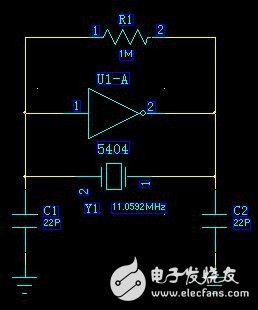Most MCU enthusiasts don't understand the capacitance near 22pF on both sides of the MCU crystal, because this capacitor can sometimes be unnecessary. Many books are referenced, and there are very few explanations. The most frequently mentioned is the stabilizing effect. The load capacitance and the like are not very in-depth theoretical analysis.
The problem is that many fans don't care about these two capacitors. They think that they can do it according to the reference design. I am also the same, until one mobile phone project has a problem because of this capacitor, and after losing a few million, it really starts. Consider the role of this capacitor.
In fact, the real name of the MCU's oscillator circuit is called "three-point capacitor oscillator circuit", please refer to the picture on the web page.

Y1 is a crystal, which is equivalent to the inductance inside the three-point type. C1 and C2 are capacitors. 5404 and R1 implement an NPN transistor. You can compare the three-point capacitor oscillation circuit in the high-frequency book. Next, analyze this circuit.
5404 must have a resistor, otherwise it is in the saturation cut-off area, not the amplification area, R1 is equivalent to the bias of the triode, so that 5404 is in the amplification area, then 5404 is an inverter, which realizes the role of the NPN transistor. The NPN transistor is also an inverter when it is connected to the common emitter.
Next, explain the working principle of this three-point oscillating circuit in a common way. You can also read the book directly.
Everyone knows that a sinusoidal oscillation circuit needs to oscillate under the condition that the system magnification is greater than 1, which is easy to implement, and the phase satisfies 360°. The following mainly explains this phase problem:
Because the 5404 is an inverter, that is to say, 180° phase shift is achieved, then it is necessary to realize 180° phase shifting of C1, C2 and Y1. Just when C1, C2, Y1 form resonance, 180 phase shift can be realized. The simplest one of us can use the ground as a reference. When resonating, the current passing through C1 and C2 is the same, and the ground is in the middle of C1 and C2, so the voltage is reversed and 180 phase shift is realized.
As C1 increases, the amplitude at the C2 end increases, and as C2 decreases, the amplitude also increases.
Sometimes C1 and C2 can start up without soldering. This is not because there is no C1, C2, but because of the distributed capacitance of the chip pins. Because this C1 and C2 do not need to be large, this is very important. Next, analyze the effect of these two capacitors on the oscillation stability.
Because the voltage feedback of 7404 is based on C2, assuming C2 is too large and the feedback voltage is too low, this is also unstable. Assume that C2 is too small, the feedback voltage is too high, the stored energy is too small, it is susceptible to external interference, and the radiation will affect the outside world. . The effect of C1 is exactly the opposite of C2. Because when we lay out the board, assuming that the double panel is thicker, the effect of the distributed capacitance is not very large. If we are considering a high-density multilayer board, we need to consider the distributed capacitance, especially the oscillation circuit such as VCO. Consider the distributed capacitance.
Some projects used for industrial control, it is recommended not to use the crystal method to oscillate, and the second is to directly connect an active crystal oscillator.
Many times, everyone will use the 32.768K clock crystal to make the clock, instead of using the crystal of the single-chip microcomputer to divide the clock and later make the clock. This reason many people don't understand, in fact, this is related to the stability of the crystal, the higher the frequency of the crystal, The Q value is generally difficult to be high, the frequency stability is not high, and the crystal stability of 32.768K is good in all aspects, forming an industrial standard, which is relatively easy to be high.
Integrated Street Light,Outdoor Street Light,Solar Street Lights,Solar Landscape Lighting
t-smartlight , https://www.t-smartlight.com